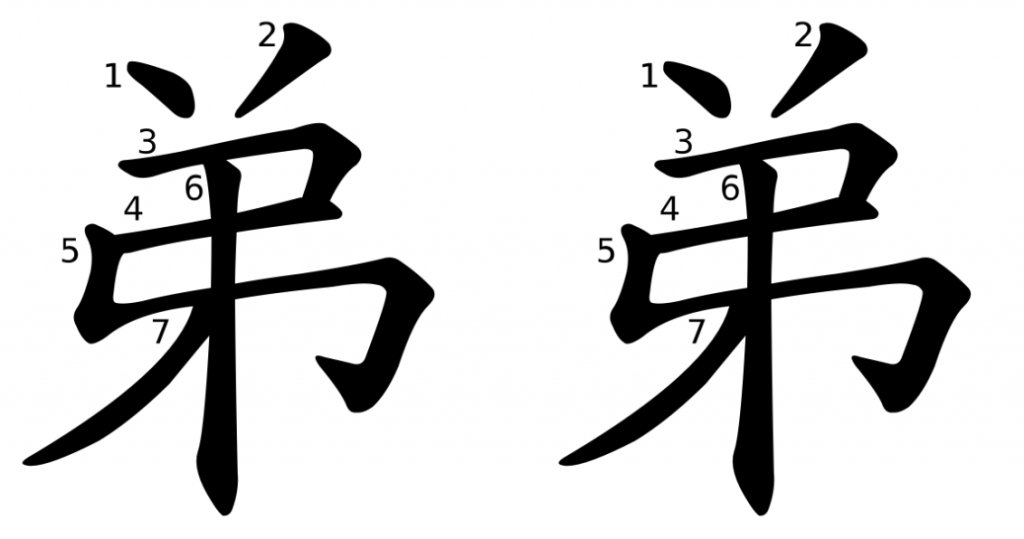Quick link:
上課/上课、第一、興奮/兴奋、覺得/觉得、老師/老师、中文班、那個人/那个人、哪國人/哪国人、就是、想要、一樣/一样、她們/她们、名字、因為/因为、所以、會中文/会中文、奇怪、大家、哥哥、弟弟
上課/上课 VO. [shàngkè] attend class. 我喜歡上中文課/我喜欢上中文课。I like attending Chinese class.

shàng: go up
radical: 一 (yī)

Chinese Studies Classroom: In Oracle Bone Script, the character “上” consists of a long horizontal line representing a baseline and a short horizontal line above it, indicating a position above the baseline. Thus, the original meaning of “上” is “high” or “above.” By extension, it refers to higher ranks or superior quality. It can also function as a verb, meaning to ascend, move upward, or advance.

kè: class
radical: 言 (yán, language)
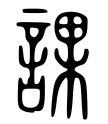
Chinese Studies Classroom: The character “課/课” has “言/讠” on the left as the semantic component, indicating its relation to speech or language. The right component, “果,” serves as the phonetic component, suggesting that in ancient times, the pronunciation of “課/课” was similar to that of “果.”
Simplified character:

第一 Num. [dìyī] the first. 我很喜歡第一課/我很喜欢第一课。I really like the first lesson.

dì: The character “第” is often used as an ordinal prefix in Chinese to indicate sequence or ranking, such as “第一” (first) or “第二” (second).
radical: 竹 (zhú, bamboo)

yī: one
radical: 一
Both traditional and simplified characters are written as:
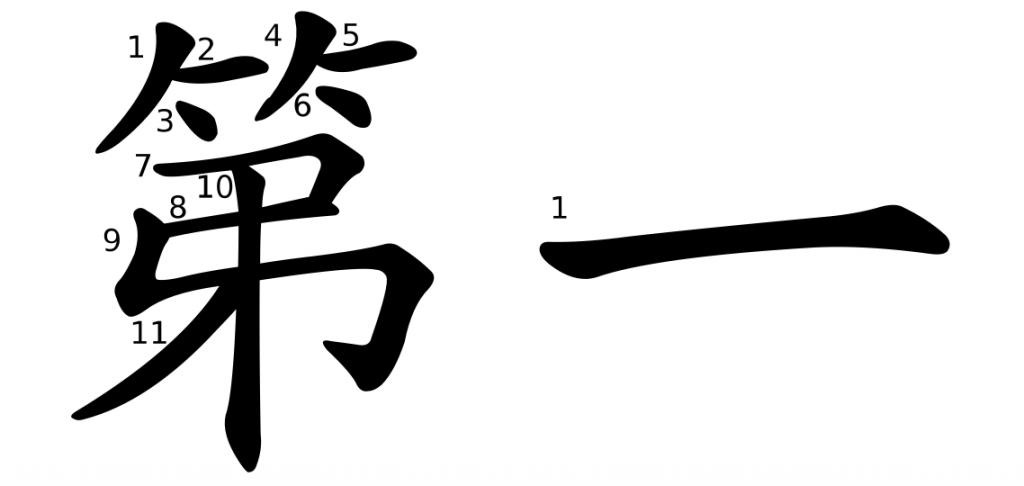
興奮/兴奋 Adj. [xīngfèn] excited. 我今天很興奮/我今天很兴奋。I am very excited today.
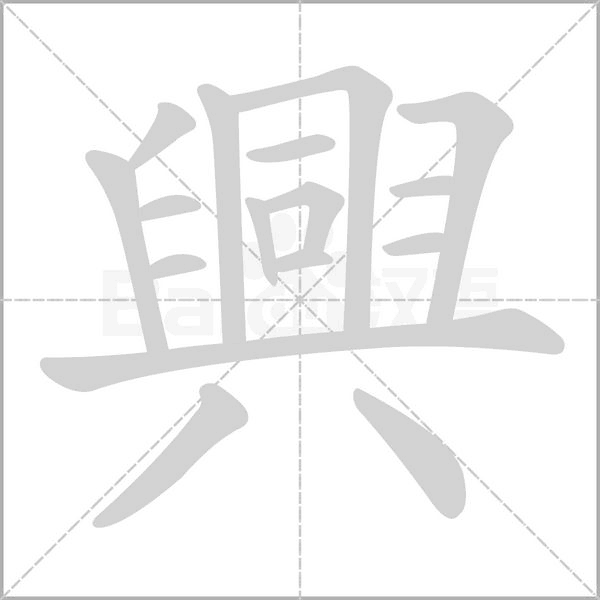
xīng: start; begin; get up; rise; prosper; rise; prevail
radical: 八

Chinese Studies Classroom: In Oracle Bone Script, the character “興” features a stretcher-like object in the center, with four hands at the corners, symbolizing the collective effort of lifting an object. Therefore, the original meaning of “興” is “to rise” or “to get up.” When used in an abstract sense, it signifies “to emerge” or “to arise.” Over time, it further extended to mean being in high spirits or feeling happy. When it specifically conveys the sense of “happiness,” the character is pronounced as “xìng.”
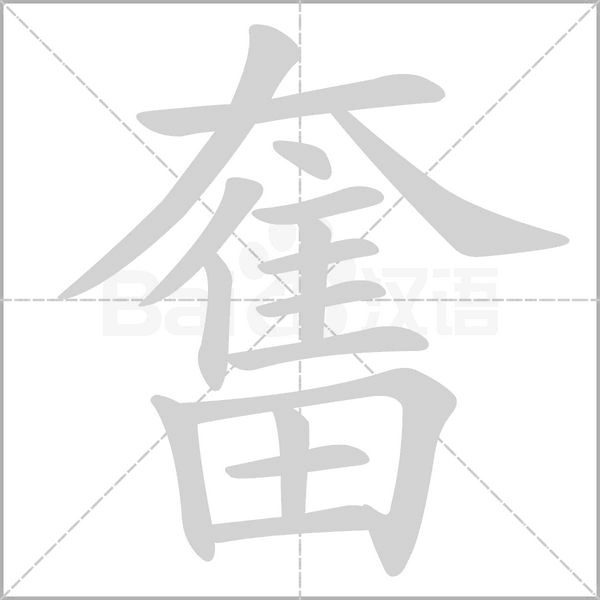
fèn: put forth energy; exert oneself; act vigorously; resolve to; wave; raise
radical: 大

Chinese Studies Classroom: The ancient form of the character “奮” resembles a bird flying out from its clothing. Therefore, the original meaning of “奮” refers to a bird flapping its wings and flying. It later extended to mean putting in one’s utmost effort to do something, and further evolved to include meanings such as “rallying” and “excited.”
Simplified character:

覺得/觉得 V. [juéde] feel; think. 我覺得他很好/我觉得他很好。I think he is very nice.
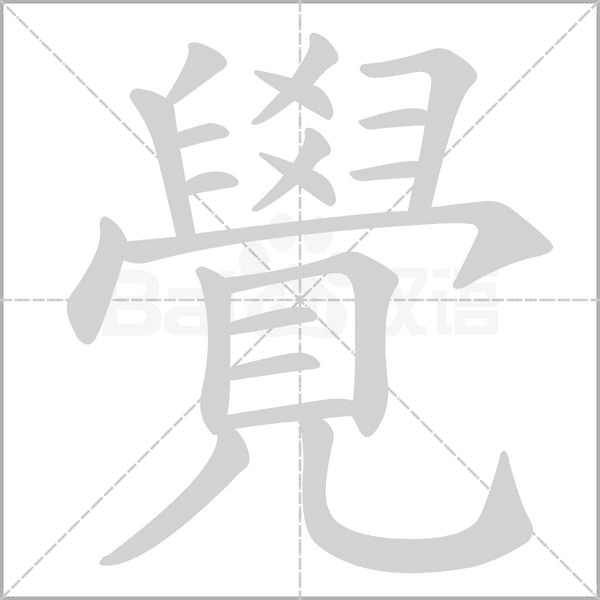
jué: feel; be aware; sense
radical: 見 (jiàn, see; catch sight of)

de: (used after a verb or adjective, it connects a complement that indicates degree or result)
radical: 彳 (chì, The appearance of taking small steps, walking slowly, or walking with pauses)
Traditional character:
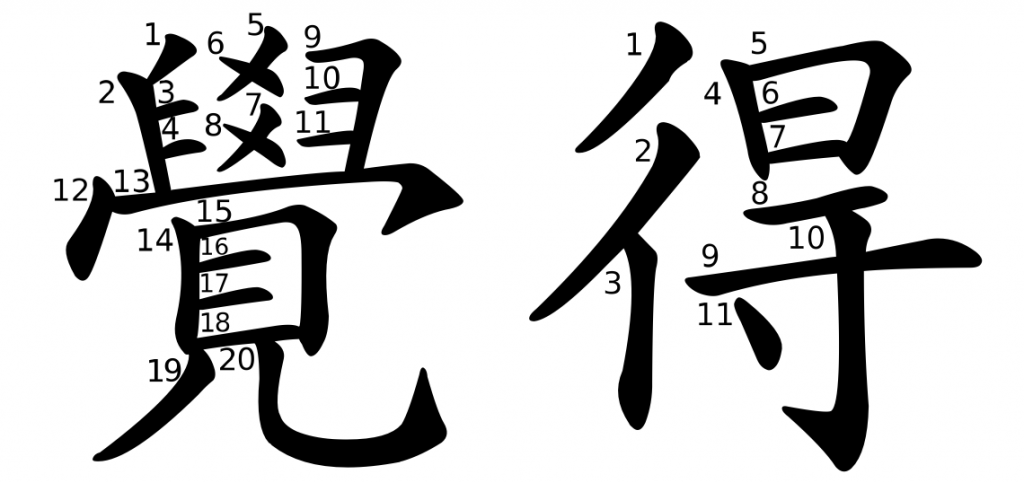
Simplified character:
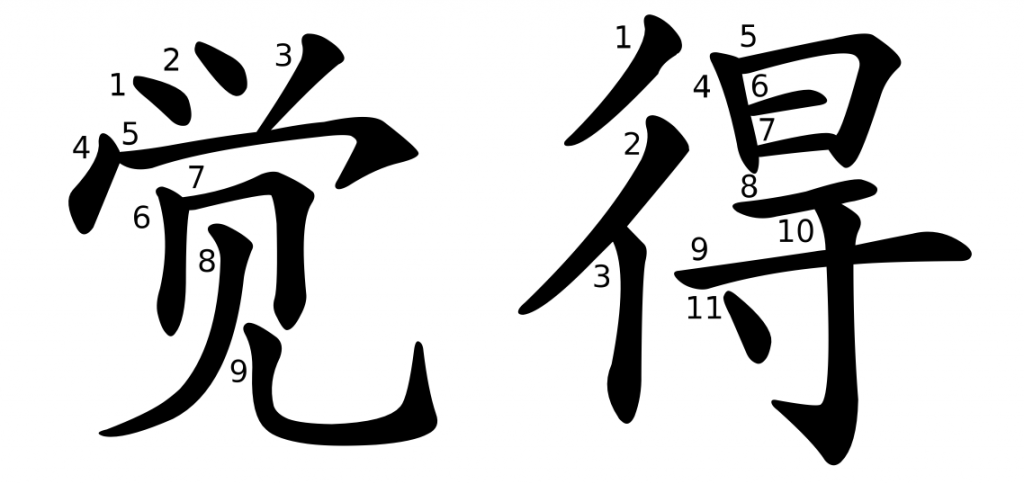
老師/老师 N. [lǎoshī] teacher. 我的老師是美國人/我的老师是美国人。My teacher is American.
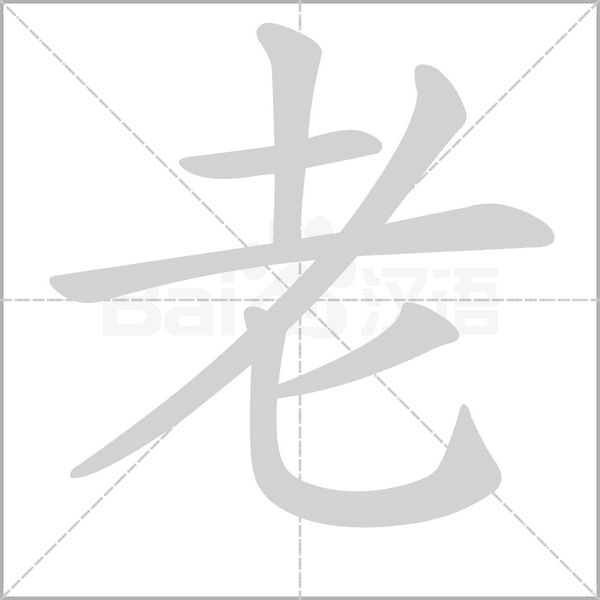
lǎo: old; “lǎo” can also be used as a prefix, commonly in words for addressing people (e.g., lǎoshī, “teacher”), indicating rank or order (e.g., lǎodà, “the eldest or the boss”), and in the names of certain animals and plants (e.g., lǎohǔ, “tiger”).
radical: 耂 (lǎo, old)
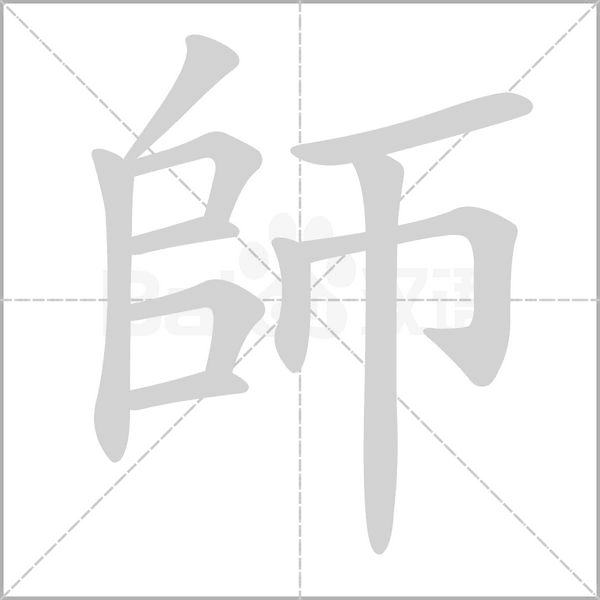
shī: teacher
radical: 𠂤 (duī, a mound of earth or a hill)

Chinese Studies Classroom: One interpretation of the character “師/师” is that in oracle bone script, its shape resembles two small hills standing upright. In ancient times, when armies went on expeditions, they often camped near hills, so the upright placement of “𠂤” (hill) came to represent the concept of an army. Thus, “師/师” originally referred to a large army. Later, it was extended to mean a teacher or someone who possesses specialized skills or knowledge.
Simplified character:
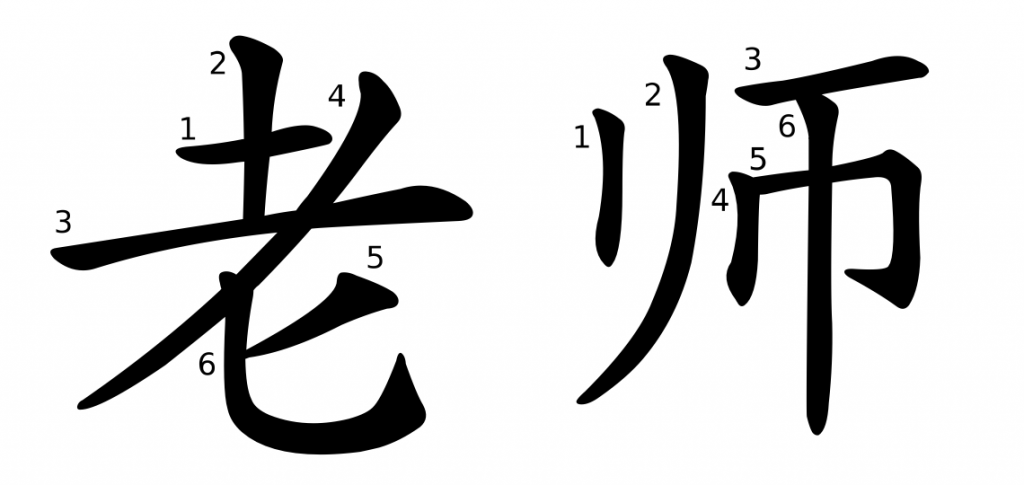
中文班 NP. [Zhōngwén bān] Chinese class. 我喜歡我中文班的老師/我喜欢我中文班的老师。I like my Chinese class teacher.
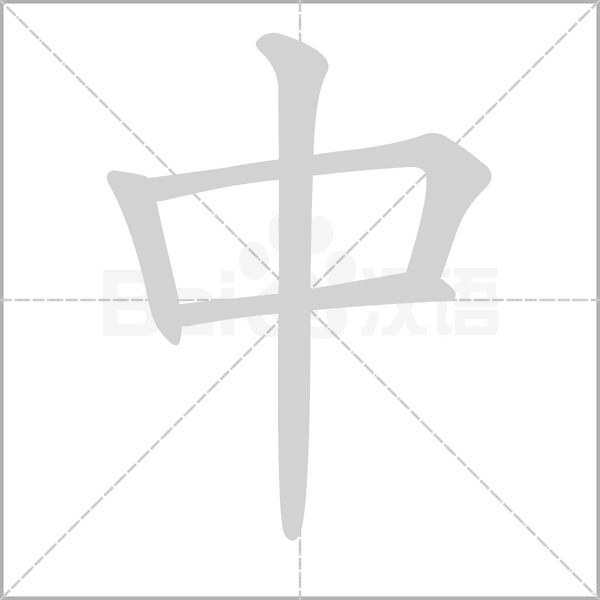
zhōng: middle
radical: 丨(gǔn, the appearance of being connected from top to bottom)

Chinese Studies Classroom: In oracle bone script, the character “中” resembles an upright flag, with two flag tassels at the top and bottom fluttering in the wind. The “口” in the middle of the two tassels represents the meaning of “center.”
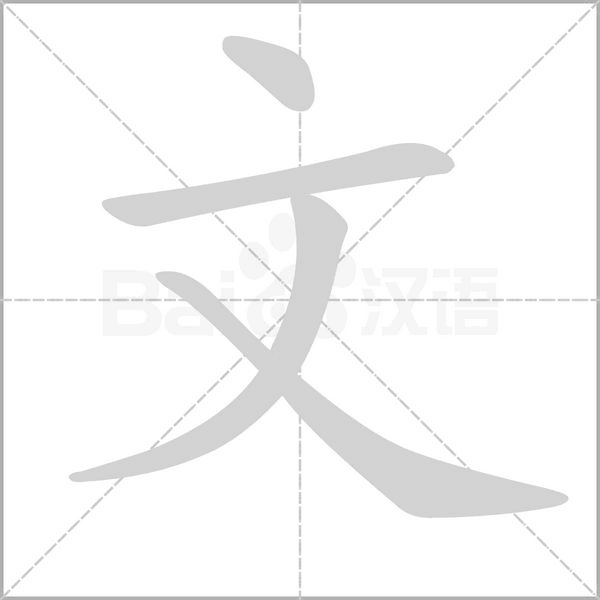
wén: character; script; writing
radical: 文 (wén; decorative pattern)

Chinese Studies Classroom: In oracle bone script, the character “文” resembles the figure of a standing person. Its original meaning referred to “tattoos” and was later extended to signify patterns and textures. Over time, it further evolved to encompass meanings such as writing, adornment, civil and military matters, astronomy, and more.

bān: class
radical: 王 (wáng/yù, jade)
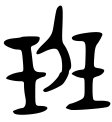
Chinese Studies Classroom: In bronze script, the character “班” has a knife in the middle and jade on both sides, resembling the act of using a knife to cut jade. The original meaning of this character was to divide jade. Later, it extended to refer to rank, class, or an organization formed based on duties.
Both traditional and simplified characters are written as:

那個人/那个人 NP. [nàge rén]/[nèige rén] that person. 那個人是我的朋友/那个人是我的朋友。That person is my friend.
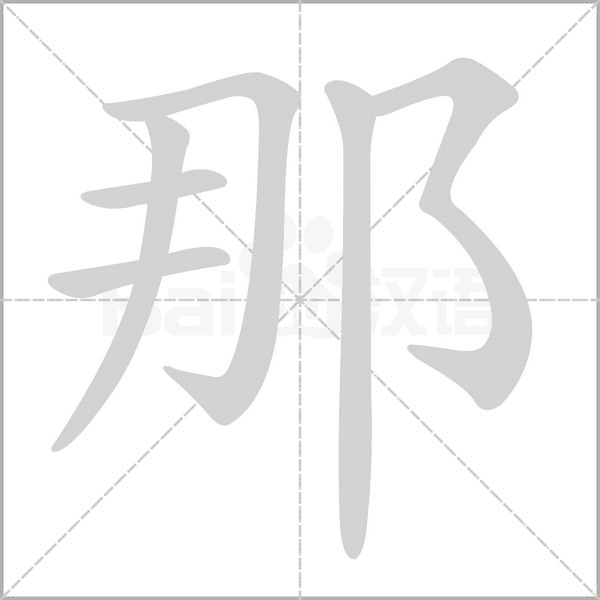
nà: that
radical: 阝(yì; a small town)

Chinese Studies Classroom: The radical “阝” can appear on either the left or the right side of a Chinese character. When it is on the right side, it is derived from the character “邑” (yì), which is associated with cities. The original meaning of “那” was a place name, and it later extended to mean the pronoun “that.”

gè: Used as a measure word, it also refers to size, body shape, or the dimensions of an object.
radical: 亻(rén, person)

rén: person; people; human
radical: 人 (rén; person)
Traditional character:

Simplified character:

哪國人/哪国人 VP. [nǎguó rén] / [něiguó rén] what nationality. 你是哪國人/你是哪国人?Which country are you from?

nǎ: which
radical: 口 (kǒu, mouth)
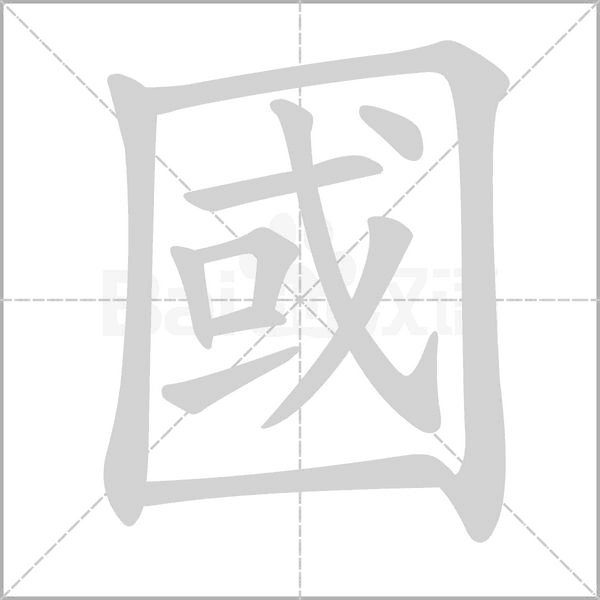
guó: country
radical: 囗 (wéi; surround)
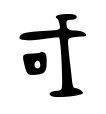
Chinese Studies Classroom: The original form of the character “國” (guó) was “或” (huò). In Shang dynasty oracle bone script, the character “國” is composed of the symbol for a weapon, “戈” (gē), and the symbol for a boundary, “囗” (wéi). Together, they convey the idea of using weapons to defend the territory and the four directions outside the city.

rén: person; people; human
radical: 人 (rén; person)
Traditional character:
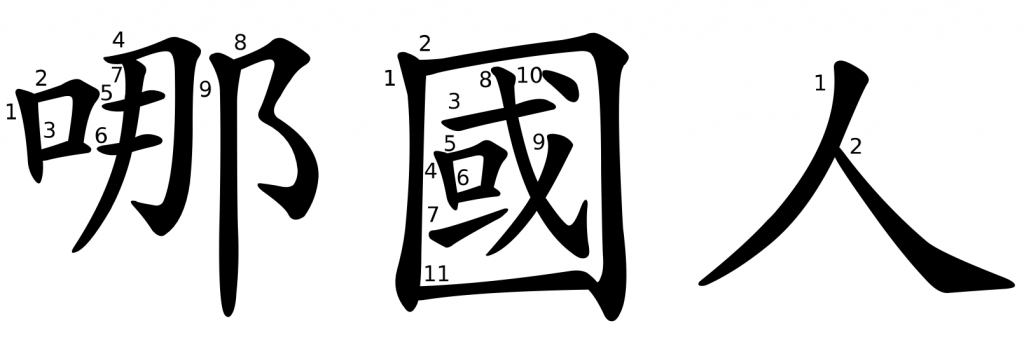
Simplified character:

就是 Adv. [jiùshì] is exactly. 我就是你的老師/我就是你的老师。I am your teacher.

jiù
adv. right away; as early as; as soon as; exactly
conj. even if
prep. with regard to
v. come near
radical: 亠
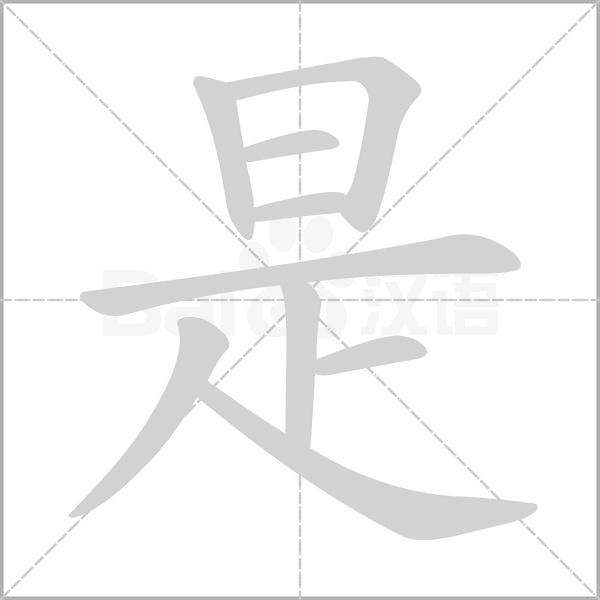
shì: be; am; is; are
radical: 日 (rì, sun)
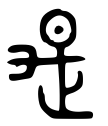
Chinese Studies Classroom: One explanation is that in the Bronze Script, the character “是” consists of a sundial on top and the character “正” (upright) below, with the basic meaning of upright and not skewed. It later extended to mean correctness and further evolved into a response word, expressing agreement or approval. After the Han dynasty, “是” was used as a copula to indicate judgment.
Both traditional and simplified characters are written as:
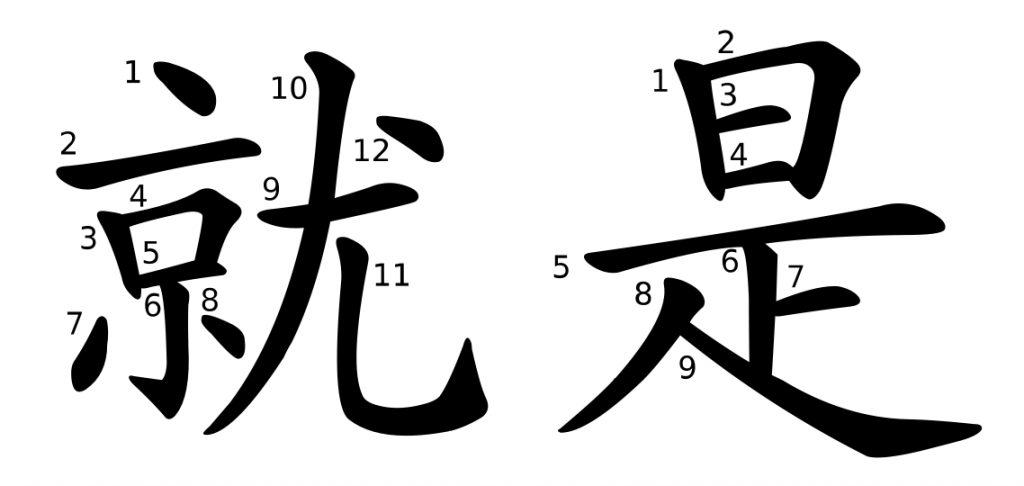
想要 VP. [xiǎngyào] want. 我想要一個中文名字/我想要一个中文名字。I want a Chinese name.
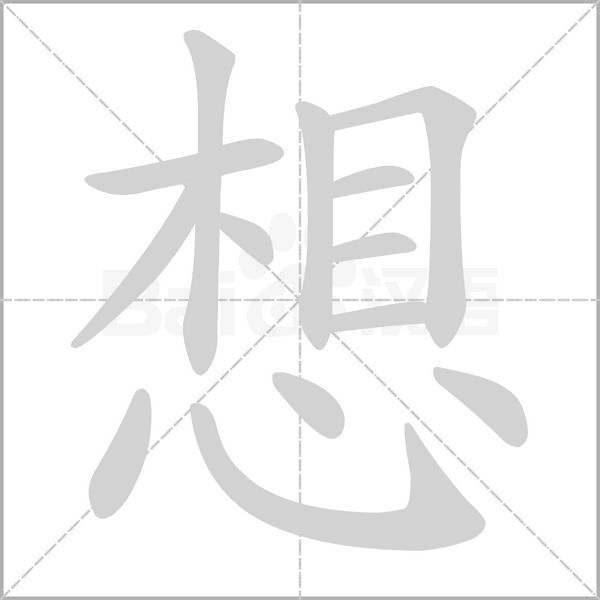
xiǎng: think; want to
radical: 心 (xīn, heart)

Chinese Studies Classroom: In the character “想,” the component “相” serves as the phonetic element, indicating that the ancient pronunciation of “想” was similar to that of “相.” The “心” (heart) component represents the semantic element. In ancient Chinese thought, the heart was considered the organ of thought, so characters containing “心” or its variant “忄” often relate to mental or emotional activities. For example: 忙 (máng, busy), 忘 (wàng, forget), and so on.
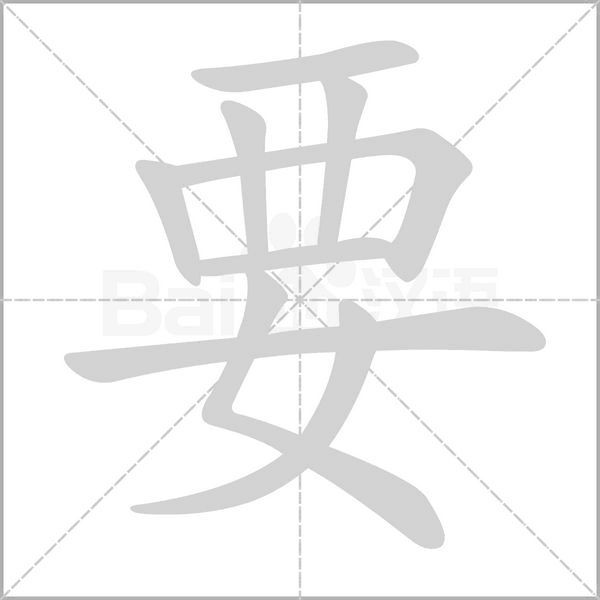
yào: want; have a desire for
radical: 女 (nǚ, female)
Both traditional and simplified characters are written as:
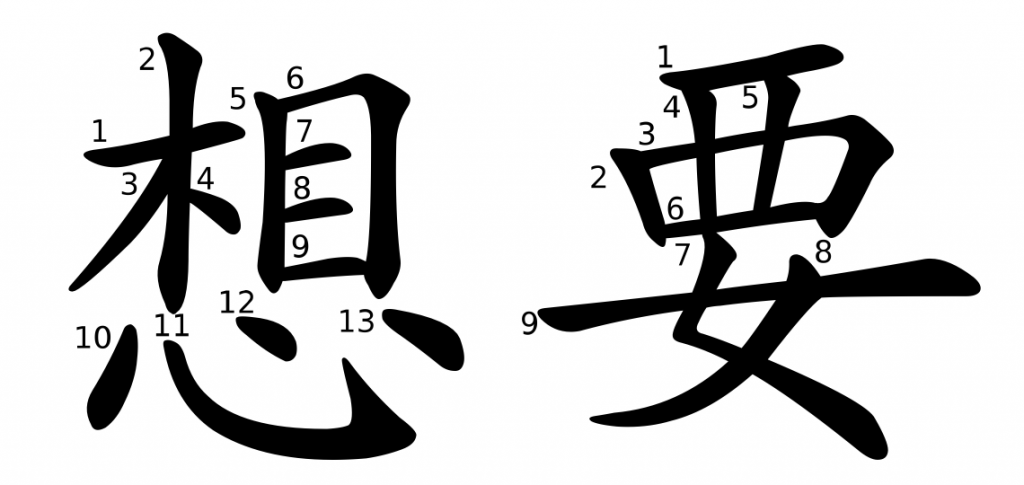
一樣/一样 Adj. [yíyàng] same. 我們一樣,我們都是美國人 / 我们一样,我们都是美国人。We are the same, we are all Americans.

yī: one
radical: 一
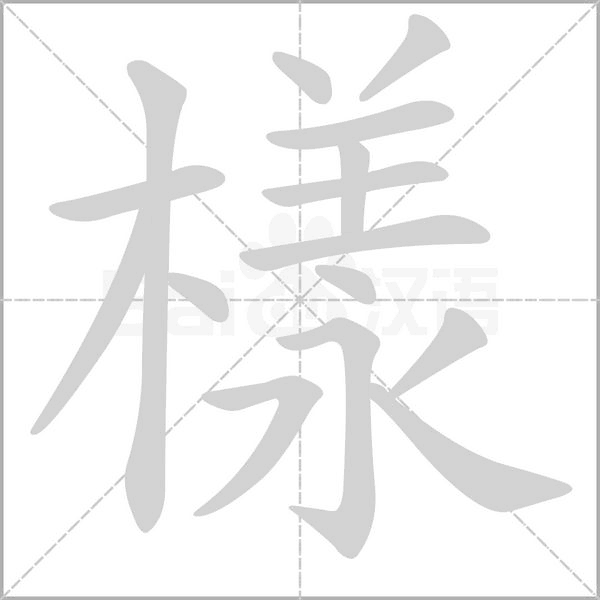
yàng
radical: 木 (mù, wood)
Traditional character:

Simplified character:
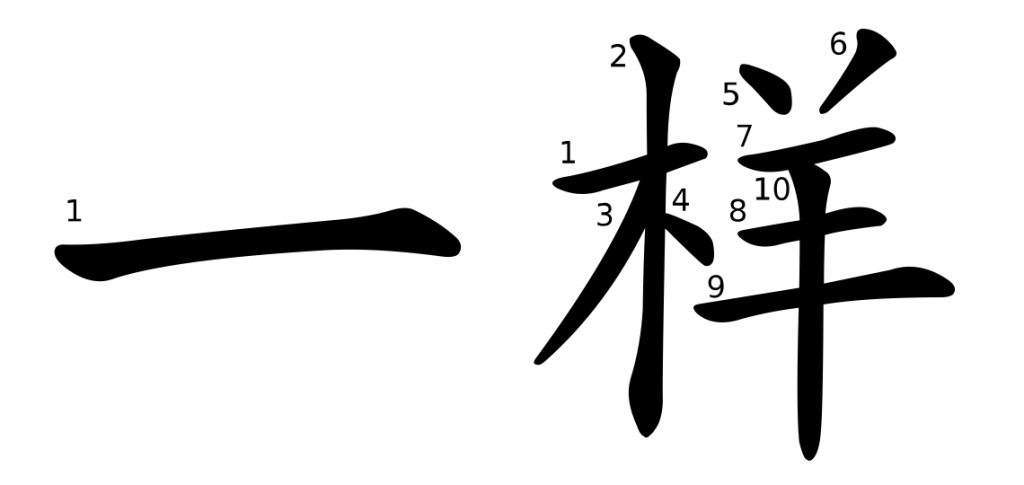
她們/她们 PP. [tāmen] they (All the people referred to are women) 她們是美國人 / 她们是美国人。They are Americans.
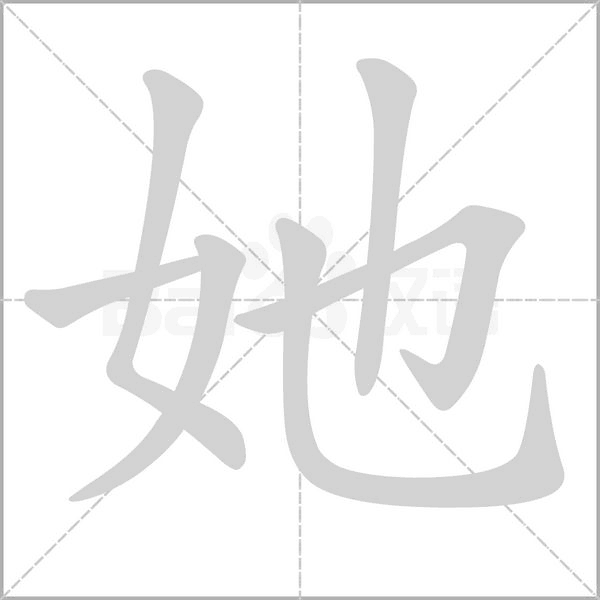
tā: she; her
radical: 女 (nǚ, female)
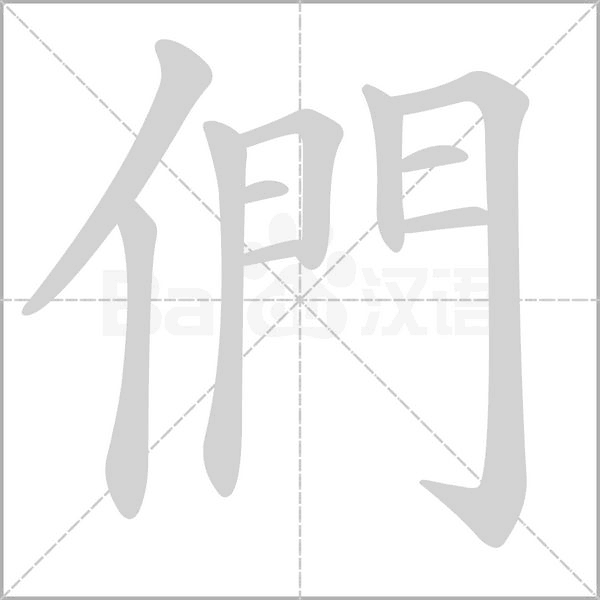
men: plural marker for pronouns and a few animate nouns
radical: 亻 (rén; person)
Traditional character:

Simplified character:
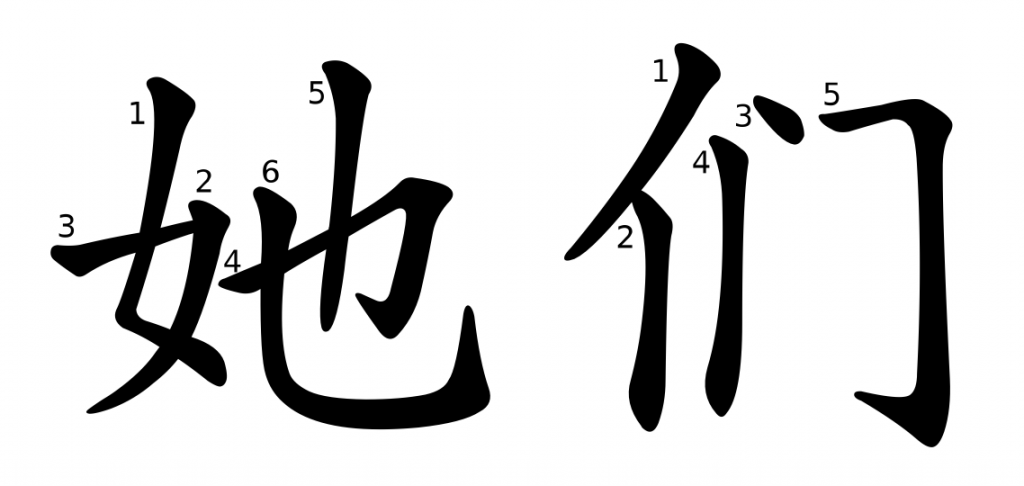
名字 N. [míngzi] name. 你叫什麼名字 / 你叫什么名字?What is your name?
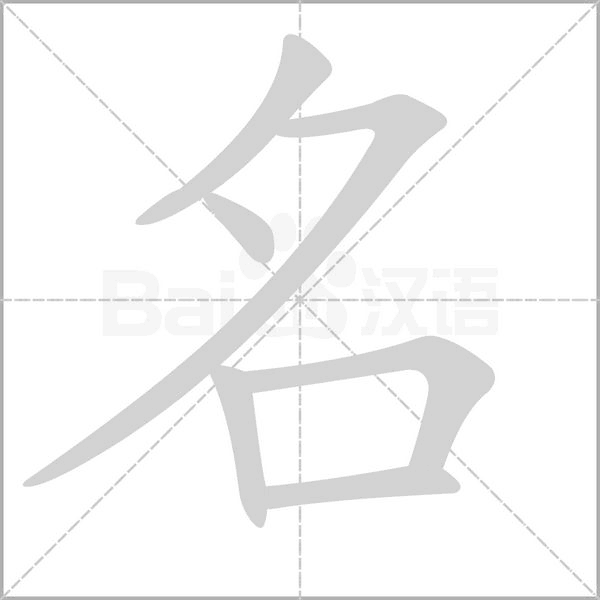
míng: to have
radical: 夕(xī, night) and 口 (kǒu, mouth)

Chinese Studies Classroom: In Oracle Bone Script, the character “名” is composed of “口” (mouth) and “夕” (night). In ancient times, when people traveled at night and couldn’t see each other, they would call out their own names. Therefore, the meaning of “名” is name.
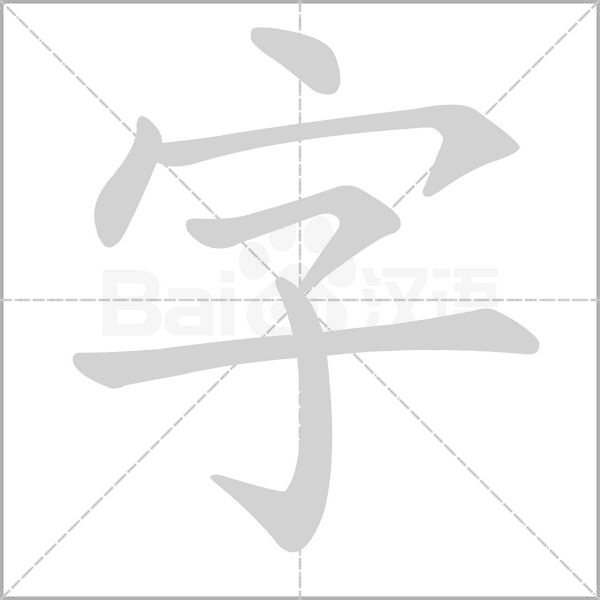
zì: character; word
radical: 宀 (mián, roof)
Both traditional and simplified characters are written as:
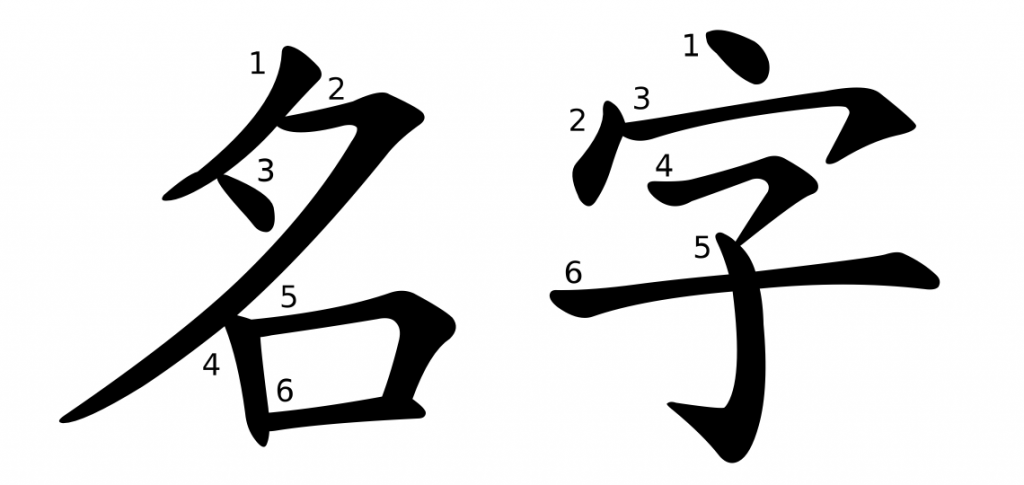
因為/因为 Conj. [yīnwèi] because. 因為我的朋友是中國人,所以我學中文 / 因为我的朋友是中国人,所以我学中文。 Because my friend is Chinese, I study Chinese.
.gif)
yīn: because
radical: 囗 (wéi, surround)

Chinese Studies Classroom: The character “因” first appeared in Shang dynasty oracle bone inscriptions. One interpretation of its ancient form suggests it resembles a person lying on a mat. Later, it extended to mean “relying on,” “depending on,” “following,” “inheriting,” “reason,” or “cause.” From the meanings of “reason” and “cause,” it further developed into the sense of “because.”
-1.gif)
wéi/wèi
radical: 灬

Chinese Studies Classroom: In oracle bone script, the character “為” depicts an elephant with a hand above its head. The original meaning of the character was to lead the elephant by hand, symbolizing taking action. Later, the character evolved from the meaning of “doing” to also represent “for,” “on behalf of,” or “because of.”
Traditional character:
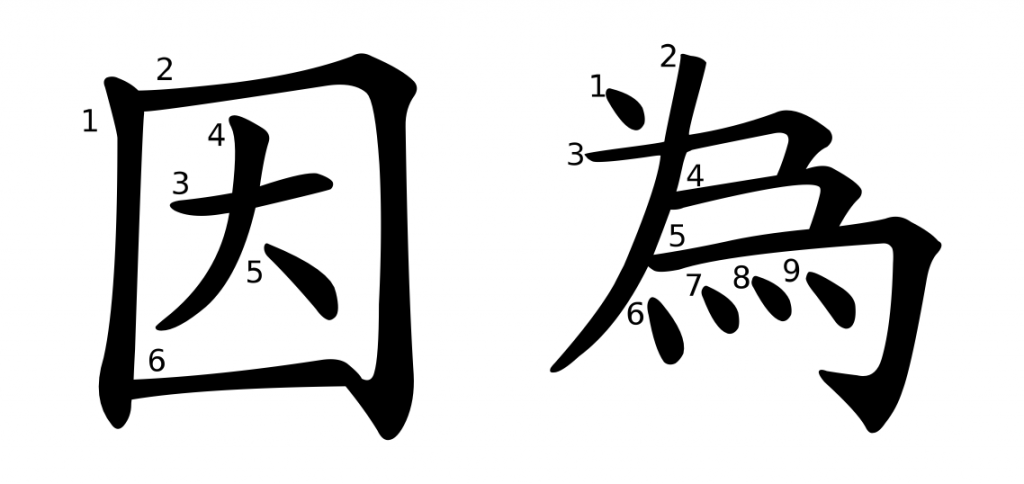
Simplified character:

所以 Conj. [suǒyǐ] therefore. 因為我喜歡中國,所以我學中文 / 因为我喜欢中国,所以我学中文。Because I like China, I study Chinese.
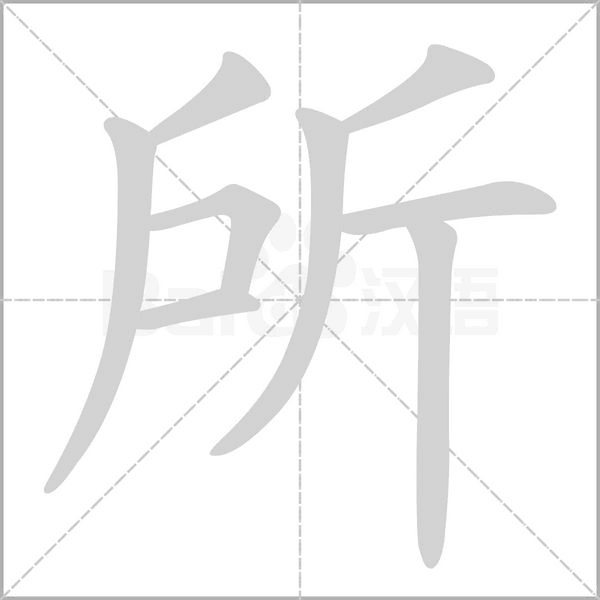
suǒ
radical: 户 (hù, door; dwelling place)

yǐ
radical: 人 (rén, person)
Both traditional and simplified characters are written as:
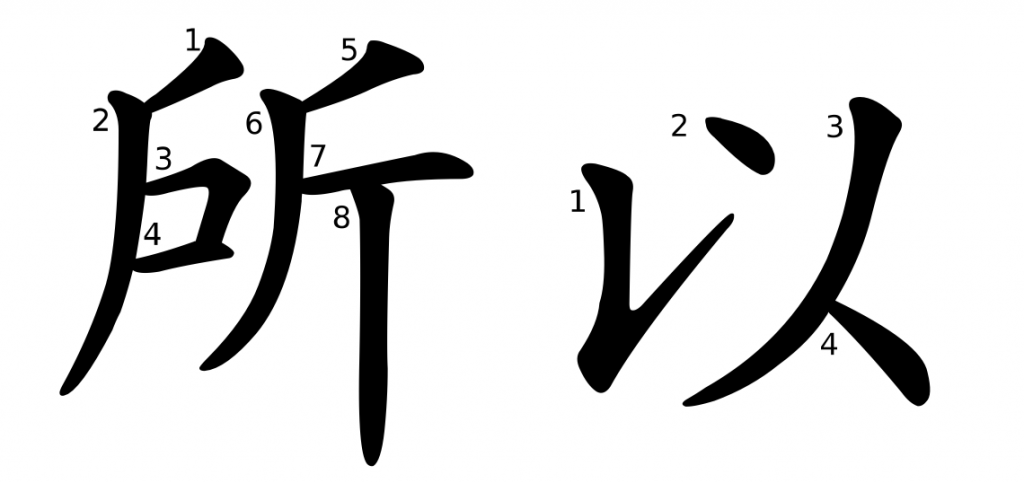
會中文/会中文 VP [huì Zhōngwén] can speak Chinese. 你會中文嗎 / 你会中文吗?Can you speak Chinese?

huì: can; be able to
radical: 人 (rén, person)
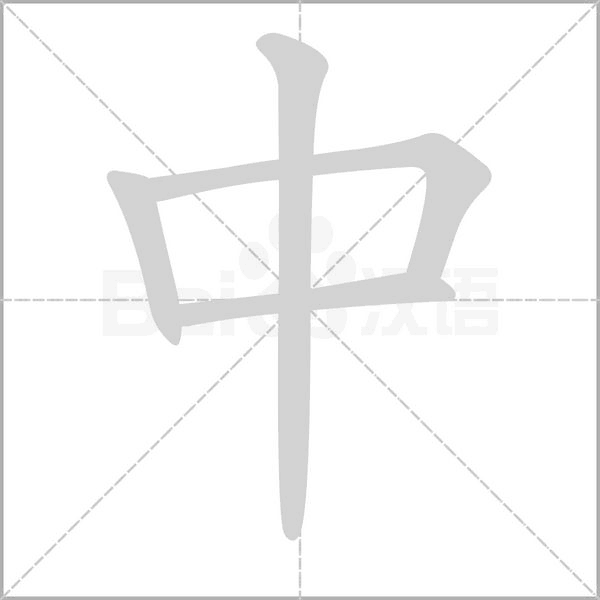
zhōng: middle
radical: 丨 (gǔn; the way it goes up and down)

wén: character; script; writing
radical: 文 (wén; decorative pattern)
Traditional character:

Simplified character:

奇怪 Adj. [qíguài] strange. 他很奇怪。He is very strange.

qí: strange; rare
radical: 大

guài: strange; abnormal; unusual
radical: 忄(xīn, heart)
Both traditional and simplified characters are written as:
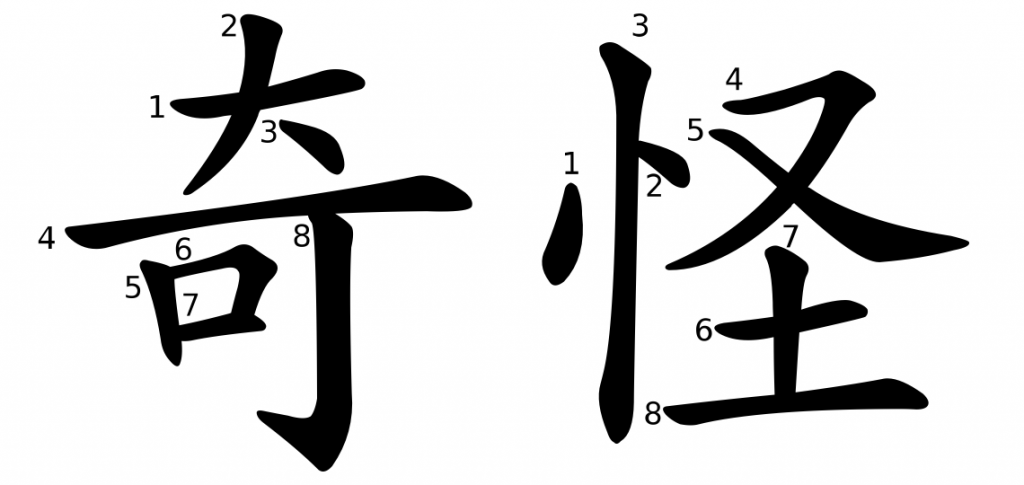
大家 N. [dàjiā] everyone; all. 大家好!Hello, everyone!
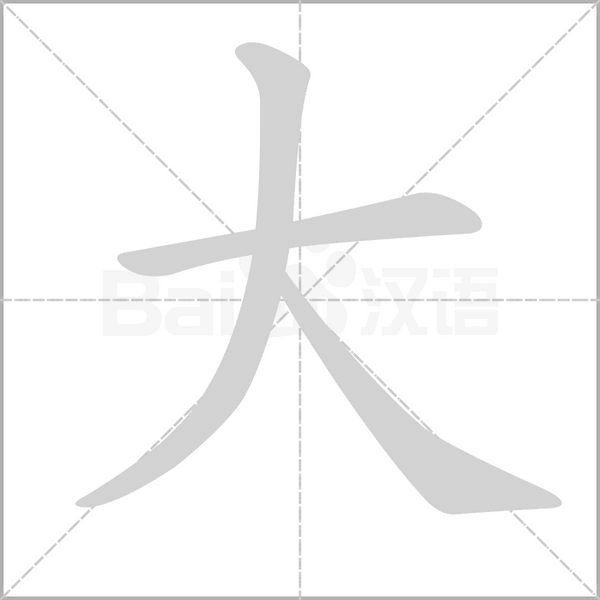
dà: big
radical: 大
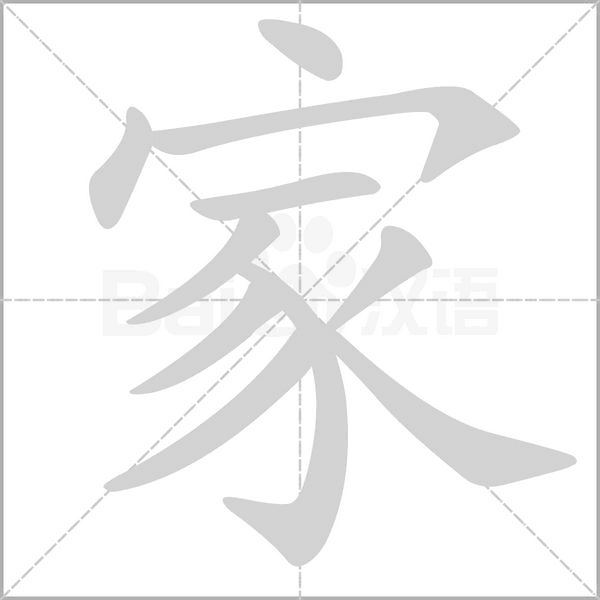
jiā: home
radical: 宀 (mián, roof)

Chinese Studies Classroom: In oracle bone script, the upper part of the character “家” (宀) represents a roof, while the lower part (豕) resembles a pig. The original meaning of “家” was a house or dwelling, and it later extended to mean “family.”
Both traditional and simplified characters are written as:
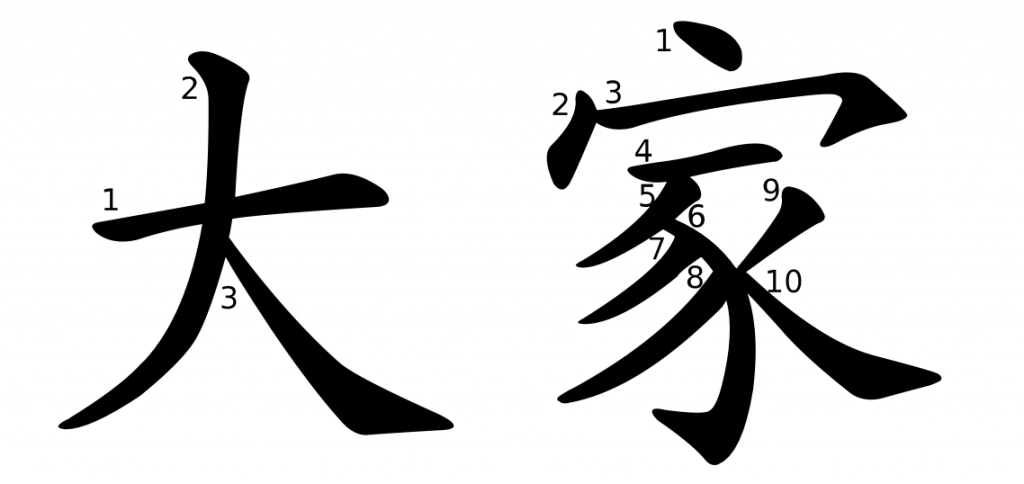
哥哥 N. [gēge] elder brother. 我哥哥是美國人 / 我哥哥是美国人。My older brother is American.

gē: elder brother
radical: 一
Both traditional and simplified characters are written as:

弟弟 N. [dìdi] younger brother. 我弟弟喜歡學中文 / 我弟弟是喜欢学中文。My younger brother likes to learn Chinese.
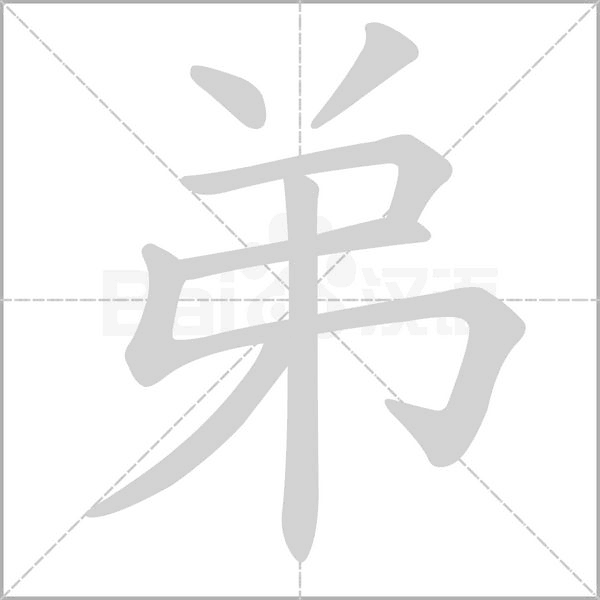
dì: younger brother
radical: 丷
Both traditional and simplified characters are written as:
